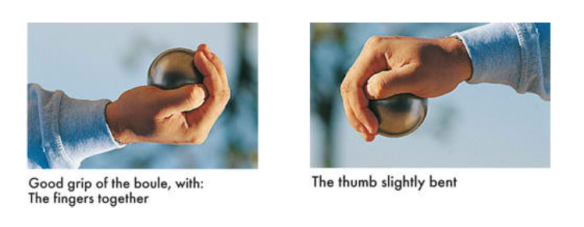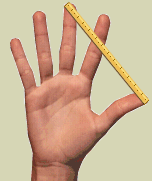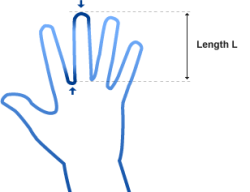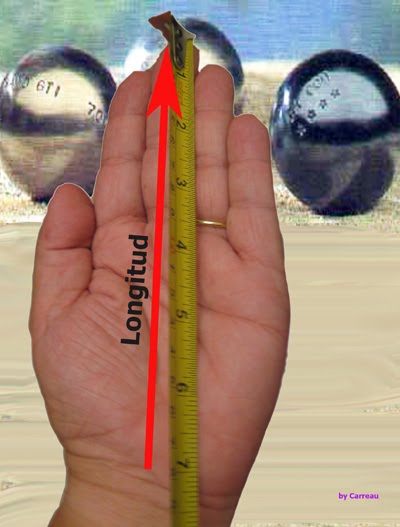Selecting competition boules – boule size - Extract from a webpage
If you click on the blue writing it will send you to another webpage and give you more information
It is only common sense that there must be some approximate relationship between the size of a person’s hand and the size of a ball that will fit comfortably into that hand.

The San Diego Petanque Club offers some sensible advice — “Too big or too small can affect the control you have over your boule, so choose whatever feels most comfortable in your hand.”
But of course you can’t just walk into your local boules shop the way you can walk into your local shoe shop, and try on boules until you find the size that fits and feels best. So: what to do?
You must make your choice of boule size before you logon and place your order. And that means that you must measure your hand, and calculate your boule size based on your hand measurement. 
A number of methods have been devised for calculating boule size based on hand size.
Method 1 – the Finger Spread Method
One proposed measurement of hand size is the distance between the tip of the thumb and the tip of the middle finger. The La Boule Bleue Create your boule web page uses such a measurement. 
 Silly website! It makes the very mistake that it warns against — that’s a picture of a left hand! The picture on the right (from the La Boule du Desert web site) is what a right-handed player should see when measuring.
Silly website! It makes the very mistake that it warns against — that’s a picture of a left hand! The picture on the right (from the La Boule du Desert web site) is what a right-handed player should see when measuring.
Anyway… The idea is that you should select your boule size based on your hand size. Here is the standard selection advice (again, with a picture of the wrong hand!) from the KTK “How to Choose your Petanque Boules” page.

Method 2 – the Finger Length Method
Obut, on their How to choose your boule page, bases boule size on the length of the middle finger. This outline is supposed to represent the back of your right hand, when you put it in a hand size gauge, such as this one from JB.
Method 3 – the Hand Length Method
La Web de la Petanca, a Spanish web site, offers advice based on total hand length.
Strangely enough, the picture illustrating the measurement shows a non-metric tape measure. And again we see a left hand.
Hand length (cm) Boule size (mm)
17.5 to 18.0 71
18.0 to 18.5 72
18.5 to 19.0 73
19.0 to 19.5 74
19.5 to 20.0 75
20.0 to 20.5 76
Comparison of the methods — a personal report
Here is a report on my personal experiences with these metrics.
I am a fairly tall adult American male, so I would expect to need a slightly larger than average boule. I measured my right hand using all of the above methods, and they all yielded similar results — a boule size of 76 mm.
Still, I had my doubts.
- Using the Finger Spread Method gave me a smaller boule size than the other methods. But I have arthritis in my right thumb, which reduces the flexibility of my right hand. When I measured my left hand, which has no arthritis, the Finger Spread method gave the same number as the other methods.
- Measures of hand size were not precise. I could get different hand (and therefore, boule) sizes depending on how hard I tried to stretch out my hand.
- In making their recommendations, some of the methods take into account what type of player you are. This practice is based on the (questionable) tradition that pointers prefer smaller boules and shooters prefer larger boules. The Obut web site, for example, uses the Finger Length Method. For the same finger-length measurement, the site recommended a boule size of 75mm or 76mm or 77mm depending on whether I considered myself to be a pointer, middleman, or shooter. Besides being confusing for a beginning player, the idea of adjusting your boule size for your style of play calls into question the whole idea of hand size alone determining boule size.
- Surfing the web, I found some indications that French players may prefer larger boules — 1mm or 2mm larger — than some players. That suggests that there is a cultural component to boule size selection, and (again) calls into question the whole idea of hand size alone determining boule size. It also suggests that boule size recommendations from French web sites may tend to be too big for some players.
Nevertheless, I went ahead and ordered a set of 76mm boules.
I was pretty happy with them for a couple of months, but I kept having the nagging feeling that they were too big. I tried a friend’s 75mm boules and liked them. So I bought a set of 75mm boules and have been playing with them. I like them, and I’m thinking of playing 75mm regularly.
My personal recommendations
Use these methods to get an estimate for a good boule size for you. But when you use them
- Favor smaller rather than larger sizes.
- When taking your hand measurements, extend your hand but don’t try to really stretch it out.
- If you need to round a measurement, round down rather than up.
- As a new player, select a boule size for a pointer rather than a middleman or a shooter.




